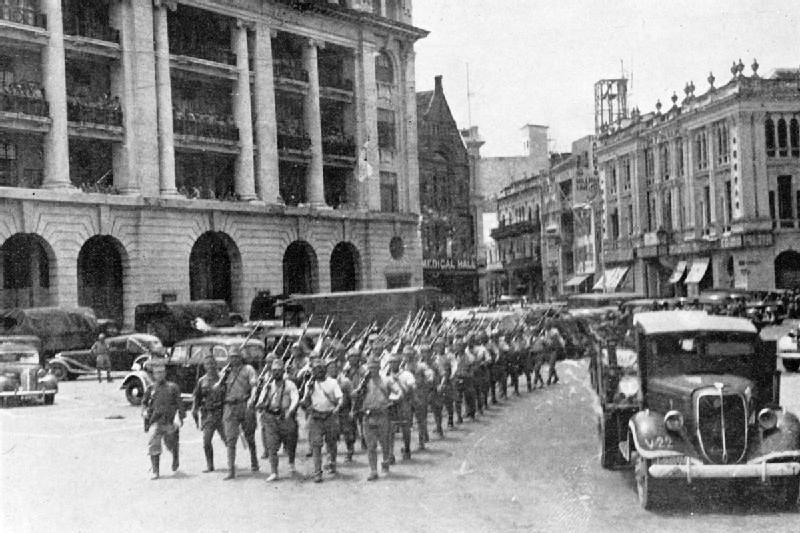The fall of Singapore: the land campaign
Posted By Joan Beaumont on February 15, 2017 @ 14:30

Nothing in history is inevitable but the fall of Singapore Island after the defeat of British forces in Malaya came close to it.
In December 1941 the Japanese established complete air and naval dominance in the region, sinking the British capital ships the Prince of Wales and the Repulse on 8 December and capturing all British air bases in northern Malaya by 20 December. Then, in January 1942, the Japanese armies under the command of Tomoyuki Yamashita advanced down the west and east coasts of the Malayan peninsula, smashing two brigades of the 11th Indian Division at Slim River and overcoming a force of Australian and Indian troops in Johore.
With the freedom to launch amphibious landings behind the British troops, the Japanese benefited from personality clashes and rapid changes within the British command, and their poor operational decisions. The Australian Major General Gordon Bennett, for instance, concentrated three-quarters of his forces on the trunk road through Johore, leaving a practically untrained Indian brigade to face the Imperial Guards Division on the important coastal road. The dramatic ambush of the Japanese 5th Division by the Australian 2/30th Battalion at Gemas, though it killed over a thousand Japanese (for fewer than fifty Australian deaths) did nothing to halt the Japanese advance down the Malayan peninsula.
When the British retreated to Singapore Island on 30-31 January 1942, the ‘Singapore strategy’ was in tatters, but could Singapore have held out longer? Perhaps. The Japanese were outnumbered and Yamashita was anxious about their supply position. Most of the naval guns on the island could turn landwards (pace popular mythology). But since they were designed to attack ships not ground targets, their ammunition was primarily armour-piercing not high explosive or fragmentation shells.
Furthermore, the British commander, Lieutenant General Arthur Percival, who lacked recent experience in operational command, misjudged the Japanese intentions, thinking that they would attack from the northeast. The Japanese instead attacked the north-west of the island, where three half-strength Australian battalions were deployed too far forward and too thinly. Overcoming the Australian resistance, the Japanese drove through the centre of the island towards Singapore Town and Keppel Harbour, but Percival’s deployments did not allow a counterattack. More prudent than willing to take risks, Percival hesitated to commit his reserves from other parts of the islands. Bennett, meanwhile, losing his cool, prematurely issued orders for a withdrawal which meant that the defensive Jurong Line was lost when it might have been held longer. By 15 February, with Singapore’s water supply in enemy hands, ammunition perilously low and civilian casualties mounting, Percival decided to surrender.
Defeats always lead to bitter recrimination. Bennett blamed the British command, the Indian troops and the British 18th Division. But although Australians are fond of seeing themselves as victims of British incompetence, the performance of Australian troops in Singapore was not faultless. Rather contemporary reports claimed that Australians were guilty of looting, left their lines too early, and crowded the wharves of Singapore in a desperate effort to escape. Sometimes Australians were described as daffodils: beautiful to look at but yellow all through. There were even reports of rapes by Australians in Malaya.
A secret British report documenting this purported indiscipline was released in 1993, and many came to the Anzacs’ defence: the Second Australian Imperial Force’s (Second AIF) 8th Division, it was argued, suffered disproportionately high casualties (10% dead); by February 1942 its units included several thousand barely trained reinforcements; and Australians lacked air cover and were subjected to heavy artillery bombardment in the final battle for Singapore.
However, the sheer number of reports criticising the performance of Australians make them difficult to dismiss. A balanced judgement is that some Australians behaved poorly in the last days at Singapore but they were not alone in this. Moreover, their lack of discipline was a symptom of the British defeat, not its cause.
For all the failures at various levels, it is hard to imagine Singapore surviving a long siege, as did Tobruk, Sebastopol or Leningrad. In early 1942 Singapore Island was simply beyond the reach of Allied logistics. Its survival had always depended on the successful defence of Malaya. This, in turn, was contingent upon the British reinforcing Malaya rather than, as Churchill decided to do in 1940-41, giving priority to the Middle East and aid to Russia (though almost none of aircraft and tanks promised to the Russians were actually sent in 1941).
The Australian Government chose in late January 1942 to warn Churchill that the evacuation of Singapore would be regarded as ‘an inexcusable betrayal’ [1]. But Churchill’s relegation of Malaya to a low priority reflected an implacable strategic reality. After the fall of France in June 1940, Britain could not hope to wage war simultaneously against Germany, Italy and Japan. The British Chiefs of Staff had known this since the mid 1930s. Australia’s political and military leaders also should have known this; but they lacked the will to confront this strategic nightmare. Three of the four divisions of the Second AIF raised in 1939-40, after all, were deployed not to Malaya and Singapore but to the Middle East.
With the surrender of Singapore at least 80,000 Allied troops were captured, including nearly 15,000 Australians. Many of them would die in captivity. Among the prisoners was Percival who spent a miserable three years in Formosa (Taiwan) and Manchuria. Bennett, however, chose to escape, purportedly because his expertise in fighting the Japanese was needed in Australia! He never held command in the field again.
Article printed from The Strategist: https://www.aspistrategist.org.au
URL to article: https://www.aspistrategist.org.au/fall-singapore-land-campaign/
URLs in this post:
[1] regarded as ‘an inexcusable betrayal’: http://dfat.gov.au/about-us/publications/historical-documents/Pages/volume-05/294-mr-john-curtin-prime-minister-to-mr-winston-churchill-uk-prime-minister.aspx
Click here to print.